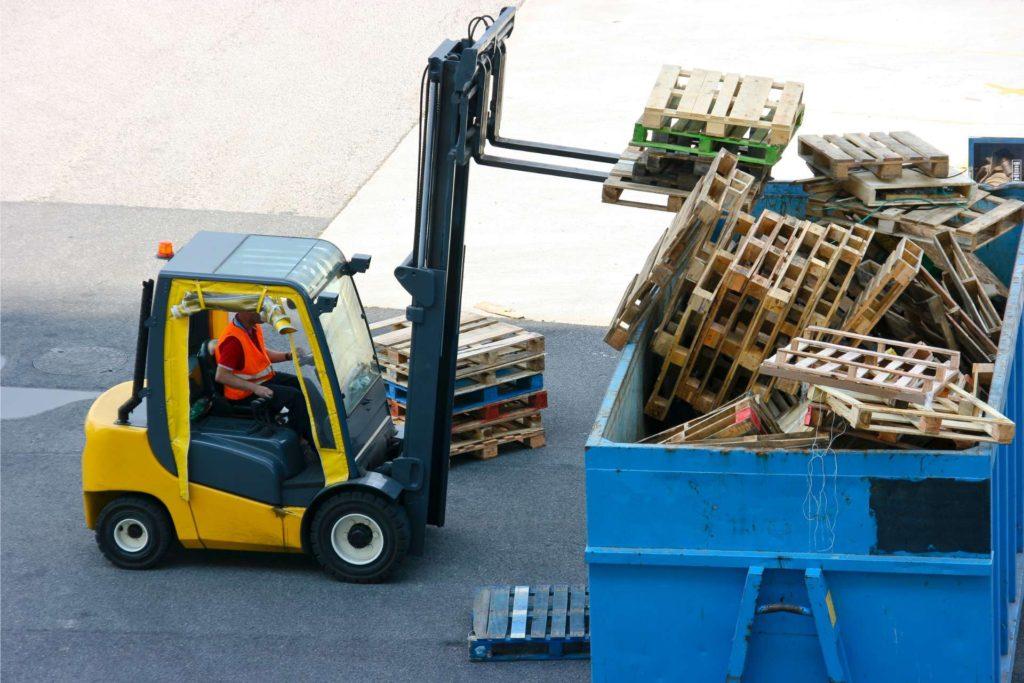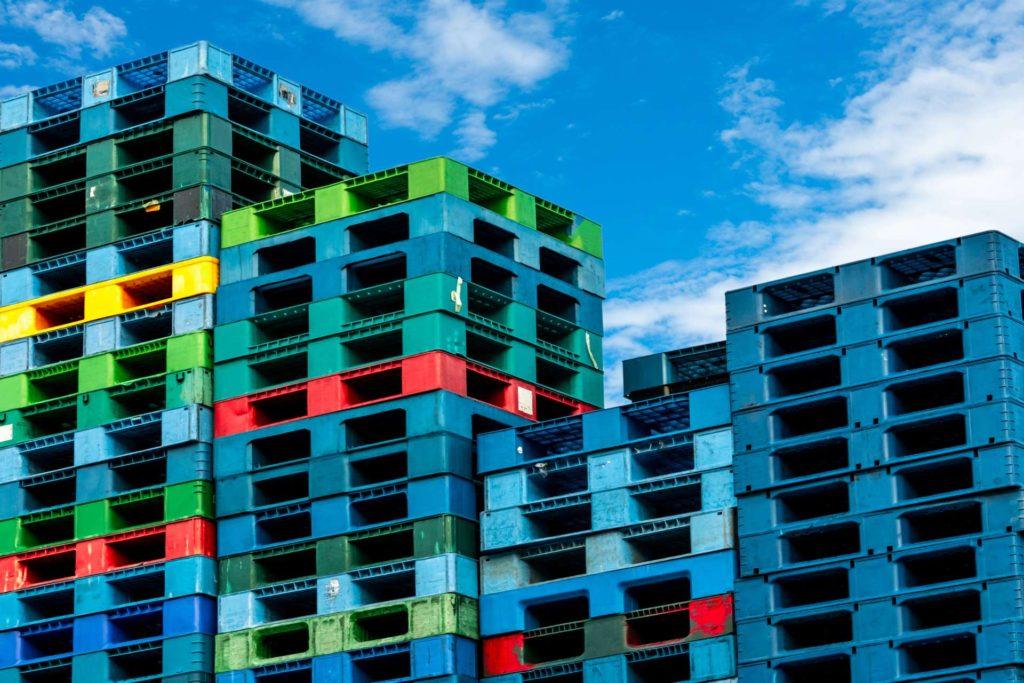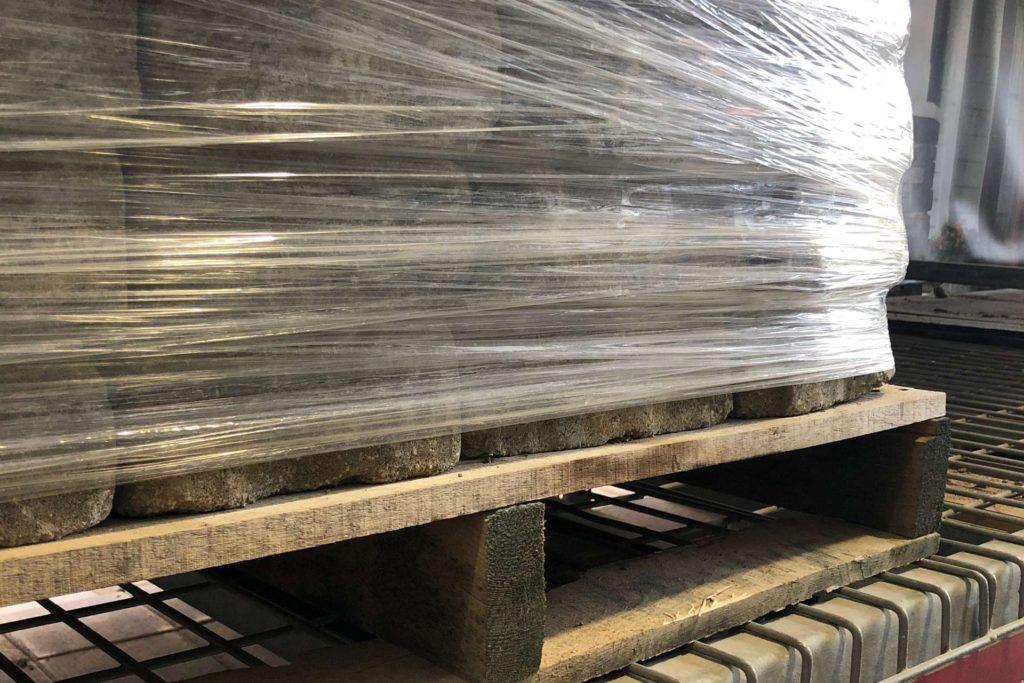As you may have read in previous blogs, we have a real focus on reducing our carbon footprint at Mitchells. We have partnered with Ecologi, become the first haulage company in the UK to purchase an 18-tonne electric truck and we’ve launched our Carbon Co-op to help our customers to offset the carbon emissions from their deliveries. Our latest article will look at how you can reduce pallet waste.
We care deeply about the environment and our role within our community. Despite all we have done so far, there is still more that can be done.
The logistics industry in the UK creates an awful lot of waste, whether that’s pallets or packaging. This waste has both an environmental impact and a financial impact, which is especially important at a time when the UK logistics industry is facing mounting cost pressures.
In this blog we will discuss the issues and provide practical steps for you to take that will have a positive impact on the environment, and provide potential cost savings.
We will be covering:
- Understanding the types of waste and their environmental and financial impact
- Smart strategies to reduce pallet waste
- The pros and cons of wood pallets v plastic pallets
- Reducing packaging waste
TLDR
Palletised distribution generates significant waste through damaged pallets, excessive packaging (wrap/straps), and incorrect pallet selection. This leads to environmental damage (deforestation, plastic pollution) and financial losses.
Solutions to reduce pallet waste:
- Proper Pallet Handling: Train forklift operators in safe techniques, conduct regular inspections, and repair damaged pallets.
- Optimised Loading: Stack loads efficiently to prevent damage, maximise space, reduce packaging, and ensure correct pallet size.
- Pallet Material Choices: Wood pallets are cheaper but prone to damage; plastic pallets are durable but pricier. Choose recyclable options.
- Minimise Packaging Waste: Use thinner, stronger wrap, automated machines, efficient wrapping techniques, and reusable options. Use correct strapping, optimise patterns, and consider sustainable materials.
Bottom line
Smart handling, optimised loading, informed material choices, and efficient packaging practices are the keys needed to reduce pallet waste, saving money, and protecting the environment.
The Waste Landscape: Understanding the Issues
Types of Waste in Palletised Distribution

It’s crucial to understand at this point that waste in the palletised distribution industry takes on a number of forms. Waste isn’t just about throwing away broken pallets; it’s a multi-faceted issue that impacts both your bottom line and the environment.
The most visible form of waste in the industry is broken pallets. Pallets can become damaged through inefficient handling, improper storage, or simple wear and tear. Cracked boards, broken stringers, and protruding nails render pallets unsafe and unusable. This leads to a cycle of disposal and replacement, consuming resources and generating waste. And with a global pallet industry worth $97.07 billion that is only expected to grow, this need for resources to replace pallets isn’t just a UK issue. Wood pallets are still the most popular type.
Incorrect pallet selection can also cause damage to pallets. Using a pallet that is too small or made of the wrong material can increase the risk of damaging the pallet. Using a lightweight pallet material for a heavy load risks structural failure and the safety of the goods. Similarly, using a heavy-duty pallet for a light load is an unnecessary expense. Additionally, using a non-standard pallet size may mean other companies are unable to reuse the pallet, leading to further waste.
Excessive packaging is also a common culprit in palletised distribution waste. While securing your load is essential, using excessive stretch wrap or strapping is both wasteful and costly. Multiple layers of wrap that are far beyond what is needed for load stability, or strapping that is applied too tightly or in an unnecessary pattern are examples of this. This not only increases material costs but also generates a significant amount of plastic waste. Often, this waste is not properly recycled and ends up in landfills.
The impact of this waste can be devastating for the environment. Deforestation and resource depletion, increased plastic pollution and waste, and the increased carbon footprint of disposal and replacement are just a few things that have a negative impact on our environment.
The financial cost of disposing of and replacing broken pallets, increased disposal fees of packaging materials and the potential for damaged goods and unhappy customers are also hard to ignore.
Minimising Pallet Waste: Smart Strategies
Reducing pallet waste isn’t just about reacting to damage; it’s about proactively implementing strategies that prevent it in the first place. Smart handling and maintenance are paramount. Here’s how to reduce pallet waste through effective practices:
Proper Pallet Handling
Reducing pallet waste begins with how your team handles these essential logistics tools. Improper handling is a leading cause of damage, leading to premature disposal. Forklift operators directly impact pallet longevity. Proper training is essential to reduce pallet waste from mishandling. Training should cover:
- Safe lifting and lowering techniques: Emphasise smooth, controlled movements to prevent impacts and stress on pallets.
- Proper fork placement: Teach operators how to correctly position forks to avoid damaging pallet stringers and boards.
- Load balancing: Educate them on the importance of evenly distributing weight to prevent pallet warping and breakage.
- Awareness of pallet condition: Encourage operators to visually inspect pallets before handling and report any damage.
- Speed and maneuvering: Training operators to move at safe speeds, especially when manoeuvring in tight spaces, will reduce impacts.
- Regular refreshers: Periodic refresher courses reinforce best practices and address any emerging issues.
By investing in thorough forklift operator training, you’re investing in the longevity of your pallets and the safety of your warehouse.
Regular Pallet Inspections And Maintenance
Regular inspections and preventative maintenance are essential to extend the lifespan of your pallets and minimise this type of waste. Implementing a system of routine inspections of all pallets, daily or weekly will identify any pallets that require maintenance. Check for:
- Cracked or broken boards.
- Damaged stringers.
- Protruding nails or fasteners.
- Signs of rot or decay.
Prompt repairs will address any damage immediately. Minor repairs, such as replacing broken boards or securing loose nails, can prevent further deterioration.
Creating a maintenance schedule will help you to keep on top of this and to normalise this kind of work: Create a maintenance schedule for tasks like:
- Nail tightening.
- Board replacement.
- Cleaning to remove debris.
Creating a dedicated repair area with the required materials and tools will provide a safe area to perform these pallet maintenance tasks. Maintaining records of inspections and tracking pallet conditions will identify any recurring issues.
By proactively inspecting and maintaining pallets rather than discarding them,, you can identify and address problems before they escalate, saving both time and money.
Optimising Pallet Loading
Beyond proper handling, the way you load your pallets is also crucial for waste reduction. Efficient loading not only protects your goods but also extends the life of your pallets. Here’s how optimising pallet loading helps minimise waste:
- Reduced damage through stability: A poorly loaded pallet, where boxes are haphazardly stacked is prone to shifting during transit, causing items to fall and potentially damage the pallet itself. Optimised loading, on the other hand, prioritises stability.
By employing techniques like interlocking stacking patterns and ensuring even weight distribution, you create a solid, secure load. This stability minimises the risk of goods shifting, thereby reducing impacts that can crack boards or break stringers. A stable load also means less stress on the pallet’s structure, preventing premature wear and tear.
- Efficient space utilisation: Wasted space on a pallet is a wasted opportunity. Overhangs, where goods extend beyond the pallet’s edges, are a major source of damage. These overhangs are vulnerable to impacts from forklifts or other pallets.
Optimising loading ensures that goods are stacked within the pallet’s boundaries, maximising surface area usage. Moreover, efficient stacking patterns allow you to utilise vertical space effectively, reducing the number of pallets needed for a shipment. This reduction in pallet usage directly translates to less waste.
- Improved load stability and reduced packaging: A well-organised load is inherently more stable. This stability reduces the need for excessive packaging materials like stretch wrap and strapping. When the load is secure, there’s less need to overcompensate with extra layers of wrap. Furthermore, a stable load is less likely to exert undue force on the pallet, reducing the chance of structural damage. In essence, optimising your load reduces the need for both pallet replacement and excess packaging.
- Reduced handling and movement: When pallets are loaded efficiently and securely, there’s less need for re-handling. Stable loads mean fewer adjustments and less movement within the warehouse. Every time a pallet is moved, there’s a risk of damage. By minimising handling, you reduce the potential for accidental drops or impacts, safeguarding both your goods and your pallets.
Pallet Materials: Wood vs. Plastic and Recyclability

The choice of pallet material significantly impacts both the environmental footprint and the operational efficiency of your distribution. Understanding the pros and cons of wood and plastic pallets, along with the importance of recyclability, is crucial for making informed decisions.
Wood Pallets
Wood pallets have long been the industry standard due to their affordability and availability. However, they come with their own set of considerations.
Advantages of wood pallets
- Cost-Effective: Wood pallets are generally less expensive than their plastic counterparts, making them a budget-friendly option.
- Repairable: Damaged wood pallets can often be repaired by replacing broken boards or stringers, extending their lifespan.
- Biodegradable (if untreated): Untreated wood is a natural, biodegradable material, meaning it decomposes over time, reducing landfill waste.
Disadvantages of wood pallets
- Susceptible to Damage: Wood is vulnerable to moisture, impact, and wear, leading to cracks, splinters, and breakage.
- Potential for Pest Infestations: Wood can harbour insects and pests, posing a risk to stored goods and potentially spreading infestations.
- Requires Treatment: To prevent pest infestations and comply with international shipping regulations, wood pallets often require heat treatment or fumigation.
ISPM 15 Standards
The International Standards For Phytosanitary Measures No. 15 (ISPM 15) is a global standard that regulates the treatment of wood packaging material used in international trade. It aims to prevent the spread of pests and diseases. Pallets that adhere to ISPM 15 standards are marked with a specific symbol, indicating they have been appropriately treated. You can read more about ISPM 15 standards here.
Plastic Pallets
Plastic pallets offer a durable and hygienic alternative to wood, but they also come with a higher initial investment.
Advantages Of Plastic Pallets
- Durable: Plastic pallets are highly resistant to impact, moisture, and chemicals, making them ideal for demanding environments.
- Hygienic: Plastic is non-porous, making it easy to clean and sanitise, reducing the risk of contamination.
- Weather-resistant: Plastic pallets are unaffected by weather conditions, making them suitable for outdoor storage.
- Recyclable: Many plastic pallets are made from recyclable materials and can be recycled at the end of their lifespan.
Disadvantages Of Plastic Pallets
- Higher initial cost: Plastic pallets typically have a higher upfront cost compared to wood pallets.
- Potential for cracking: While durable, plastic pallets can crack or break under extreme stress or impact.
- Not always easily repairable: Repairing damaged plastic pallets can be more challenging than repairing wood pallets.
Recyclable Pallets
Choosing recyclable pallet materials is a crucial step towards sustainable distribution. Recyclable pallets help reduce the environmental impact of palletised distribution by minimising landfill waste and conserving resources. Choosing materials that can be reprocessed into new products promotes a circular economy.
To identify and select recyclable pallets look for those made from recyclable materials, such as high-density polyethylene (HDPE) or polypropylene (PP). Check for recycling symbols or labels that indicate the material type. Inquire with your pallet supplier about their recycling programs and the recyclability of their products.
Pallet recycling offers a sustainable alternative to disposal. Reusing or repurposing pallets can extend their lifespan, reduce the need for new pallet production and minimise waste going to landfill.
The pallet recycling process typically involves:
- Gathering used pallets from various sources.
- Separating pallets based on material type and condition.
- Shredding or grinding plastic pallets into small pieces. Wood pallets may be disassembled.
- Melting and moulding plastic pieces into new pallets or other products. Wood can be turned into mulch or other wood products.
- By participating in pallet recycling programs, you contribute to a more sustainable and environmentally responsible supply chain.
Pallet recycling offers a practical and sustainable solution to disposal. Through reuse and repurposing, we can extend pallet lifecycles, decrease the need for newly manufactured pallets, and effectively minimise waste.
Reducing Packaging Waste: Wrap and Strapping

Beyond the pallets themselves, the packaging materials used to secure your loads significantly contribute to waste. Reducing the use of stretch wrap and strapping is not only cost-effective but also essential for creating an environmentally responsible supply chain. Let’s explore how to minimise waste in these areas.
Minimising Wrap Waste
Stretch wrap is a common and necessary tool, but its overuse leads to significant plastic waste. Here’s how to reduce your wrap consumption:
- Using thinner but stronger stretch wrap: Advances in materials technology have led to the development of high-performance stretch wraps that offer the same strength and load stability with reduced thickness. Switching to these thinner, yet stronger, wraps can significantly reduce the amount of plastic used per pallet.
- Investing in automated wrapping machines with precise tension control: Automated wrapping machines provide consistent and precise tension control, ensuring that the optimal amount of wrap is applied. This eliminates the variability and potential for over-wrapping that can occur with manual wrapping. Look for machines with adjustable tension settings to fine-tune the wrapping process for different load types.
- Training staff on efficient wrapping techniques: Even with automated systems, proper training is essential. Educate your staff on efficient wrapping techniques, emphasising the importance of applying the correct tension and overlap. Show them how to identify and avoid over-wrapping. Regular training sessions can reinforce best practices and ensure consistent application.
- Investigating reusable wrapping options: Explore reusable wrapping solutions, such as stretch hooding or reusable pallet covers. These options can significantly reduce or even eliminate the need for single-use stretch wrap. Although there is an initial expense, the long-term savings can be significant.
- Optimising techniques and materials: Review your current wrapping practices and identify areas for improvement. Experiment with different wrapping patterns and materials to find the most efficient and effective solution. Using the correct materials for the load is very important.
Reducing Strapping Waste
Strapping, like stretch wrap, can be a source of significant waste if not used efficiently. Here’s how to minimise strapping consumption:
- Using the correct type and width of strapping: Choosing the right type and width of strapping for your load is crucial. Using excessively wide or strong strapping for light loads is wasteful. Consult with your strapping supplier to determine the optimal strapping for your specific needs.
- Optimising strapping patterns: Experiment with different strapping patterns to find the most efficient and effective way to secure your loads. Properly applied strapping can be more effective than excessive amounts of poorly applied strapping. Use only as much strapping as is needed to secure the load.
- Exploring alternative strapping materials (e.g., paper-based): Consider switching to more sustainable strapping materials, such as paper-based strapping. These alternatives offer comparable strength and performance while reducing your environmental impact. Investigate the sustainability certifications of your strapping products.
Optimising your wrapping and strapping techniques, and using the correct materials, can significantly reduce this type of waste.
How To Reduce Pallet Waste: A Recap
Minimising waste isn’t just about saving money; it’s about building a more sustainable and efficient supply chain. By implementing proper pallet handling, optimising loading techniques, making informed material choices, and reducing packaging waste, you can significantly lessen your environmental footprint and boost your bottom line.
The key takeaways are clear: proactive maintenance and handling prevent damage, efficient loading maximises space and reduces packaging, and choosing recyclable materials supports a circular economy. These actions translate to tangible benefits: reduced material costs, lower disposal fees, improved operational efficiency, and a stronger brand reputation.
We encourage you to take the insights shared in this article and translate them into actionable steps within your own operations. Start by assessing your current practices, identifying areas for improvement, and implementing the suggested strategies. Train your staff, invest in the right equipment, and foster a culture of sustainability throughout your organisation.
Remember, the journey towards sustainability is a continuous process. Every step you take, no matter how small, contributes to a larger positive impact. In a world increasingly conscious of environmental responsibility, adopting sustainable practices is not just a choice; it’s a necessity. By making conscious decisions about pallet handling, loading, materials, and packaging, you’re not just reducing waste; you’re helping to build a more resilient, responsible, and sustainable future for your business and the planet.